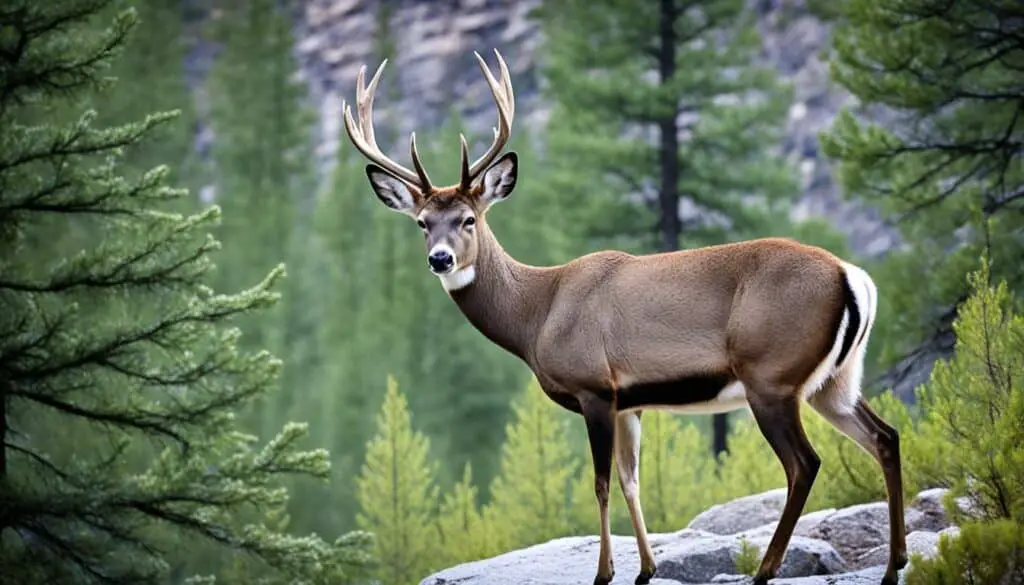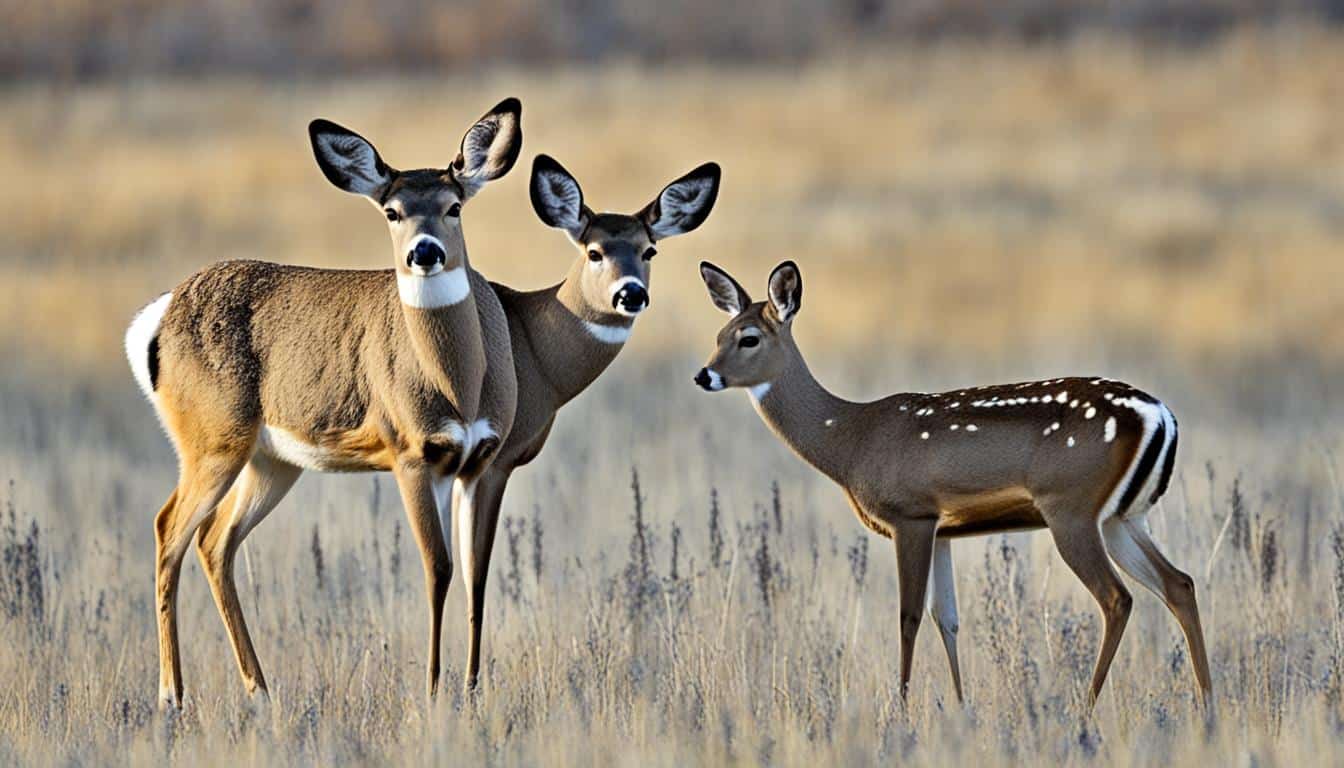Have you ever wondered how to tell mule deer apart from white-tailed deer? It’s essential for those who love wildlife or go hunting. Look closely at ear shape, tail, antlers, body color, and how they behave. Mule deer stand out with big ears and their jumping-like run. White-tailed deer have smaller ears and a unique way of alerting by raising their tails. Observing these traits can help you tell the difference.
Seeing what makes mule deer and white-tailed deer different brings depth to your outdoor experiences. It also helps you be more respectful towards nature. Let’s dive into these amazing details.
Ears Differences in Mule Deer and White-Tailed Deer
One big way to tell mule deer and whitetail deer apart is by looking at their ears. Mule deer have big ears, much like a mule’s. These ears are about three-quarters of their head length. They sit at a 30-degree angle, making them very noticeable.
On the other hand, white-tailed deer have shorter, rounder ears. These ears point more straight up. They don’t stand out like the mule deer’s ears do.
The size and angle of the ears are key differences between them. They can help you figure out which is which, even if you can’t see other parts clearly. Ears are a good clue in telling mule deer and white-tailed deer apart.
Telling Mule Deer and White-Tailed Deer Apart by Tail Characteristics
Spotting the difference between mule deer and white-tailed deer comes down to their tail. You can know right away which is which just by looking at their tails. Let’s dive into what makes each species’ tail unique.
White-Tailed Deer Tail Features
White-tailed deer have a distinctive long, brown tail with a white belly. Normally, you don’t see the white part because it’s hidden. But, if they’re scared or warning others, they ‘flag’ by lifting their tail. This action shows off their white, fluffy rear. It’s a key way to spot a white-tailed deer.
Mule Deer Tail Features
Mule deer, on the other hand, boast a shorter tail with a black tip. No matter how their tail is, a large white spot on their rump stands out. This black-tipped tail and big white patch help a lot in identifying mule deer. Even at a distance, you can tell by these unique features.
Antlers Comparison: Mule Deer vs White-Tailed Deer
Looking at the antlers of mule deer and white-tailed deer, you’ll see they’re quite different. Mule deer antlers are tall and wide. They often split into two directions, creating extra points. This makes them look very complex.
White-tailed deer, however, have simpler antlers. Their antlers grow a bit like arms reaching out to hug someone. Knowing these features is key, especially for hunters and those interested in deer.
The table below shows some of the main differences:
| Species | Antler Structure | Main Characteristics |
|---|---|---|
| Mule Deer | Bifurcated, forking in multiple directions | Tall, broad, complex branching |
| White-Tailed Deer | Single main beam with protruding tines | Resembles hugging-arm pattern |
Learning these antler details is important for anyone who loves studying deer. It helps tell mule deer and white-tailed deer apart. This knowledge is critical for hunters, nature lovers, and photographers.
Coloration and Coat Differences
Deer’s coloration and coat help us tell mule deer apart from white-tailed deer. It’s interesting to see how their fur changes with the seasons. This change makes their fur better for their habitats.
Seasonal Changes in Coloration
Both mule deer and white-tailed deer change color with the seasons. In spring and summer, they turn reddish-brown. This color helps them hide from enemies in the green surroundings.
In fall and winter, their coats become grayish-brown. Now, they stay warm and look like the trees and snow around them. This change is key to surviving in their homes.
Comparative Fur Shades
Even if their coats change at the same times, distinct colors tell the deer apart. Mule deer have a grayish-brown color. White-tailed deer are often a reddish-brown, especially in warmer months.
| Feature | Mule Deer | White-Tailed Deer |
|---|---|---|
| Spring/Summer Coat | Grayish-Brown | Reddish-Brown |
| Fall/Winter Coat | Grayish-Brown | Grayish-Brown |
While these color changes can help tell the deer apart, it’s not always easy. Sometimes, deer of different kinds may look almost the same.
Body Size and Weight: Mule Deer vs White-Tailed Deer
One important thing to look at is the size of mule deer and white-tailed deer. Mule deer are usually bigger. Their bucks can weigh 125 to 250 pounds, and does 100 to 220 pounds. On the other hand, white-tailed deer are generally smaller. Bucks weigh about 130 to 220 pounds, and does range from 90 to 200 pounds.
What makes the size difference? Mule deer body size and white-tailed deer weight are influenced by age, where they live, and what they eat. Although these factors are key, mule deer’s natural build tends to make them the bigger species.
| Deer Type | Bucks (lbs) | Does (lbs) |
|---|---|---|
| Mule Deer | 125-250 | 100-220 |
| White-Tailed Deer | 130-220 | 90-200 |
When we think about deer size comparison, mule deer come out on top. They are generally heavier than white-tailed deer. Still, it’s important to know that there can be differences even within each species. This shows we need to understand more than just their weight and size.
Identifying Mule Deer and White-Tailed Deer by Behavior
Knowing how deer act is key to telling them apart. Their behaviors make it easy to see the difference between mule deer and white-tailed deer. This goes beyond just their looks.
Unique White-Tailed Deer Behaviors
White-tailed deer have some standout habits. They have a special way of running called a gallop. This gallop, plus lifting their tails to show white, warns their herd of danger.
Another thing about them is they start breeding early. This makes them more common in their areas than mule deer.
Mule Deer Movements and Actions
Mule deer are known for how they jump. They do a stiff-legged hop, which helps them in rough lands. It’s a unique way they move.
They also take longer to grow up than white-tailed deer. Their breeding season starts later, in November. These differences in behavior help us know which deer is which.
Muzzle and Facial Markings
Knowing the deer facial features comparison details is key. This helps to tell mule deer and white-tailed deer apart. Mule deer have mainly white faces. This white area goes from their noses to their eyes. It makes them easy to pick out.
On the other hand, white-tailed deer have darker faces. What really stands out are the white rings around their eyes and nose. This is an easy way to spot the difference when tails and antlers aren’t visible. Knowing their deer facial features comparison well is very important.
| Feature | Mule Deer | White-Tailed Deer |
|---|---|---|
| Muzzle Color | Predominantly White | Darker with White Rings |
| Eye Markings | No White Rings | White Rings Around Eyes |
| Total Face Color | Wide White Area | Dark with Contrasts |
Looking at the muzzle markings in deer is a good start. They often show if it’s a mule or white-tailed deer. This knowledge is great for spotting them in the wild. Even when you can’t see all their features, you might still guess correctly.
How do you distinguish between a mule deer and a white-tailed deer?
It’s possible to tell mule deer and white-tailed deer apart by looking closely at the way they look and act. They have specific physical and behavioral features that make it easy to know the difference. We can look at the size and shape of their ears, tails, the way their antlers grow, their coat color, and the markings on their faces.
One important feature is the ears. Mule deer have big ears, like a mule, that are slightly forward-facing. White-tailed deer, instead, have smaller, round ears that point straight up.
Their tails are also a giveaway. A white-tailed deer has a long, brown tail. It shows white when they’re alarmed. Mule deer have a short tail with a black tip and a big white area on its backside.
Looking at their antlers can also help. Mule deer have antlers that split into different points. White-tailed deer, however, have antlers that grow in a single, unbroken line.
The color of their coats is another clue. Mule deer are usually grayish-brown. White-tailed deer often look more reddish-brown, especially in warm weather.
Size and weight set them apart too. Mule deer are generally bigger, with bucks weighing 125-250 pounds, and white-tailed deer bucks weigh less, about 130-220 pounds. The same goes for the does of each species.
Looking at their faces can be telling. Mule deer have mainly white faces from nose to eyes. White-tailed deer have darker faces with white circles around their eyes and nose.
How they move is unique as well. Mule deer leap in a stiff-legged style, called stotting. White-tailed deer have a different leap, and they lift their tails to warn others when in danger.
| Characteristic | Mule Deer | White-Tailed Deer |
|---|---|---|
| Ears | Large, set at an angle | Smaller, erect |
| Tail | Short, black-tipped with white rump patch | Long, brown with white underside, used for flagging |
| Antlers | Bifurcated, with multiple forks | Single main beam with individual tines |
| Coat Color | Grayish-brown | Reddish-brown |
| Size and Weight | Larger, bucks: 125-250 lbs, does: 100-220 lbs | Smaller, bucks: 130-220 lbs, does: 90-200 lbs |
| Facial Markings | White face from nose to eyes | Darker face with white rings around eyes and nose |
| Behavior | Stiff-legged stotting | Galloping, tail-raising warning signal |
Habitats of Mule Deer and White-Tailed Deer
Mule deer live in western North America. They mostly like dry places, open woods, and forests. This helps them survive in places with little water and tough land.

On the other hand, white-tailed deer do well in many different places in the Americas. They are found in forests, farmland, and brushy areas. This makes them common in a wide variety of ecosystems.
Knowing where these deer live can help tell them apart. Here’s a simple comparison of their habitats to help you understand better:
| Deer Species | Preferred Habitats |
|---|---|
| Mule Deer | Arid environments, open woods, forests in western North America |
| White-Tailed Deer | Forests, farmland, brushy areas across the Americas |
Learning about mule deer and white-tailed deer habitats can improve your ability to spot them. It helps you better identify the species you see.
Breeding and Reproduction Differences
Knowing about deer breeding cycles is vital for taking care of our wild places. Mule deer take longer to grow up and have babies. They mate from mid- to late-November. Then, they carry their babies for seven months. Fawns are born in late spring or early summer.
White-tailed deer, on the other hand, have babies more often and earlier. Females can have babies at just six months old. Their mating season is from late-November to early December. They are pregnant for six and a half months. This leads to young deer being born in late spring.
The reproductive differences in deer show big variations in how their groups grow. Because mule deer take longer to reproduce, their populations grow differently. This affects how we care for them. For white-tailed deer, their quick reproduction means we need to think of different ways to protect them. Keeping watch on these deer breeding cycles helps us make smart choices for wildlife care and saving.
FAQ
How do you distinguish between a mule deer and a white-tailed deer?
Spot the differences by looking at their ears, tails, and body features. Mule deer have big ears, while white-tailed deer have smaller ones. You can also tell by the colors and patterns on their bodies. Mule deer, for example, have a white patch on their rump. Each deer also has different antlers. Mule deer’s antlers are tall and split into two, looking like a fork. In comparison, white-tailed deer have straighter antlers that branch out.
What are the ear differences in mule deer and white-tailed deer?
Mule deer have large ears like a mule, while white-tailed deer have smaller, round ears.
How can you tell mule deer and white-tailed deer apart by their tail characteristics?
The tail differences are big clues. White-tailed deer have a long, bushy tail. It’s dark on top and white underneath. When they’re scared, they raise their tail to show the white, which is called “flagging.” On the other hand, mule deer have a shorter tail with a black tip. They also have a big white patch on their rump that you can always see.
How do mule deer vs white-tailed deer antlers differ?
Mule deer’s antlers are larger and split into two, like a fork. White-tailed deer have antlers with one main beam and tines growing off of it. They don’t split into two like mule deer’s.
Are there coloration and coat differences between mule deer and white-tailed deer?
Both deer change their coats with the seasons. They have reddish-brown coats in warm months and grayish-brown in the cold. Usually, mule deer are more grayish, and white-tailed deer are more reddish. But their coat colors can vary, making it tricky to use this to tell them apart sometimes.
How do body size and weight differ between mule deer and white-tailed deer?
Mule deer are bigger than white-tailed deer. Bucks can weigh from 125 to 250 pounds, while does weigh 100 to 220 pounds. White-tailed deer are lighter, with bucks between 130 and 220 pounds, and does 90 to 200 pounds. Remember, age and food change their sizes too.
What unique behaviors help identify white-tailed deer?
Look for their leaping run, called a gallop, and the way they warn others by showing the white under their tail. They also start having babies earlier than mule deer do.
What movements and actions are characteristic of mule deer?
Mule deer leap with their legs straight in a way called stotting. They mature slower than white-tailed deer and usually mate from mid- to late-November.
How do muzzle and facial markings differ between mule deer and white-tailed deer?
Their faces look different too. Mule deer have white faces. White-tailed deer have darker faces but with white rings around their eyes and nose. This is a good way to tell them apart if you can’t see their tail or antlers.
What are the habitat preferences of mule deer vs white-tailed deer?
Mule deer like the arid West of North America, living in open woods. White-tailed deer are found in more places across the Americas, liking forests, farmland, and dense areas.
How do breeding and reproduction differ between mule deer and white-tailed deer?
Mule deer mature later and mate from mid- to late-November. Their babies come after seven months. White-tailed deer breed sooner, with some ready at six months. They mate from late-November to early December and have babies after a shorter, six and a half months.







